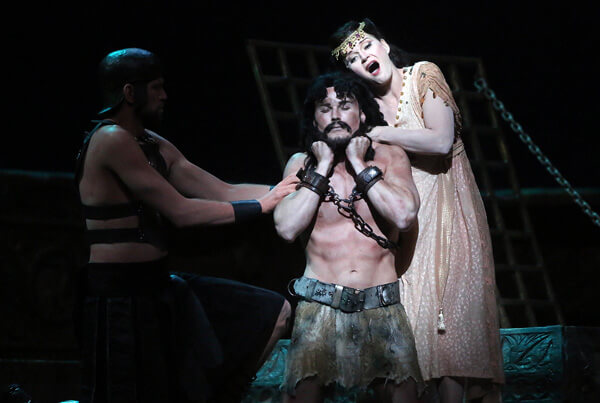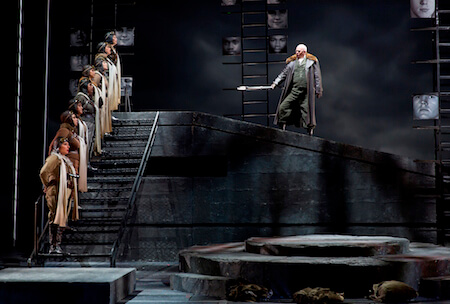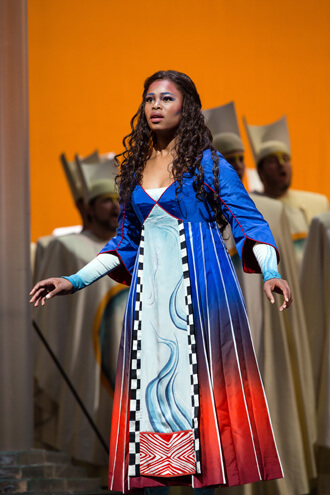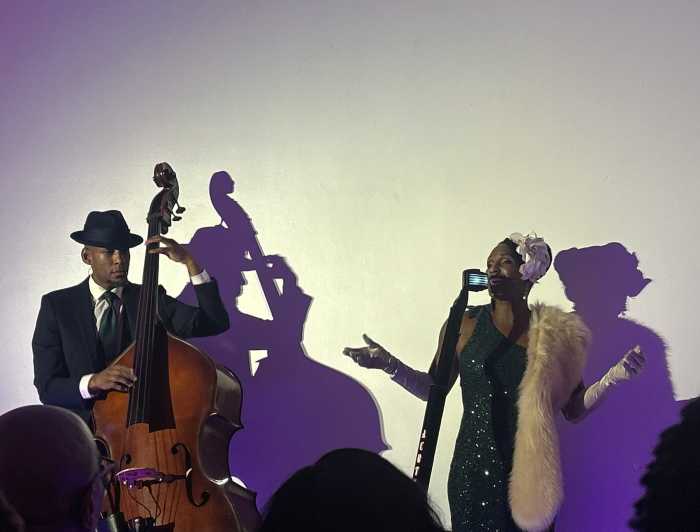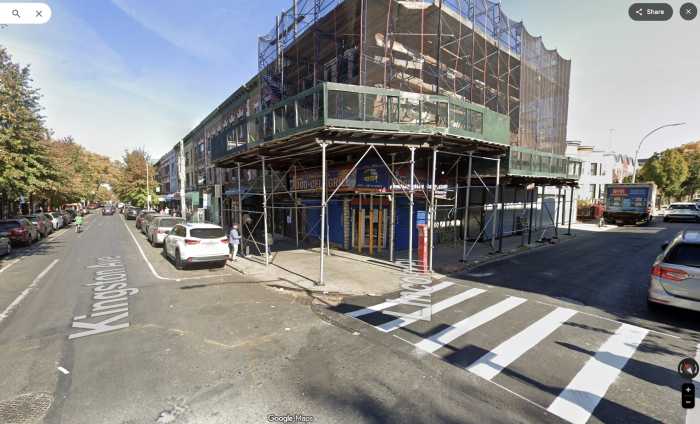Ryan McKinny and Erika Sunnegårdh in Palm Beach Opera’s production of Strauss’ “Salome.” | COURTESY: PALM BEACH OPERA
New York City Opera’s recent winter season at BAM showed a company rising like a phoenix from its own ashes. While its old productions were broken up and auctioned off as souvenirs, George Steel’s new vision for the company took shape. No longer competing with the Met, NYCO focused on boutique repertory in smart, hip, high-concept productions.
Thomas Adès’ 1995 “Powder Her Face” a fragmentary, dream-like exploration of the empty, sybaritic, and scandalous life of Margaret, Duchess of Argyll received a presentation worthy of an international festival. Unlike Adès’ heavy, effect-laden score for “The Tempest,” “Powder Her Face” has a light, playful touch and a clever, insightful libretto by Philip Hensher. Adès’ musical style mixes Britten into an acidic cocktail of Stravinsky, Weill, and Berg.
“Powder Her Face,” “Turn of the Screw” by NYCO at BAM, “Salome” in Palm Beach escape
Director Jay Scheib’s multimedia production followed Margaret, who never seemed to change over five decades, through a series of elegantly appointed, interchangeable hotel suites while live video feeds were projected on the walls. The action was enlivened by the appearance of a non-singing chorus of 25 nude men representing the nymphomaniac noblewoman’s many extramarital lovers. The sardonic, cynical tone of the piece deepened into real heartbreak as the Duchess, old and alone, comes to the realization that the only people in her life who were nice to her were paid for it.
As Margaret, British debutant Allison Cook had an icy Charlotte Rampling beauty and cool, even mezzo-soprano intriguingly at odds with the character’s aggressive sexuality. Tenor William Ferguson played various waiters and hangers on — including one bellboy inveigled into onstage fellatio — with protean ease. Bass Matt Boehler was equally versatile as various authority figures, including the cuckolded Duke and hotel managers with unpaid bills. Coloratura Nili Riemer as the Maid handled Adès’ often awkwardly angular and high-lying vocal writing with ease.
Conductor Jonathan Stockhammer elicited assured playing from a much-improved and more polished and cohesive orchestral ensemble.
NYCO last presented Britten’s “Turn of the Screw” in 1996 in a Mark Lamos production that suggested the ghosts haunting Bly were figments of the Governess’ sexually repressed and increasingly unhinged imagination. In the Lamos production, John Conklin’s expressionistic Victorian settings became increasingly “Cabinet of Dr. Caligari”-surreal as the protagonist descended into madness.
Sam Buntrock’s new production for NYCO updated the action to England circa 1980, and in the manner of Stephen King, the paranormal seeped into the dark hidden corners of seemingly ordinary suburban life. Quint appeared as the reflection in the screen of a tube television set or in an upstairs bedroom window. The ghosts here were real, and the Governess remained sane, if increasingly emotionally fragile.
Sara Jakubiak sang the Governess with sensitivity and a flawless British accent. Tenor Dominic Armstrong fielded a seductively rich lyric tenor sound as Quint and as the Prologue. Benjamin P. Wenzelberg played young Miles with a disturbingly ambiguous childlike openness, while Lauren Worsham hinted at the damage beneath Flora’s girlish eagerness. The company’s new music director, Jayce Ogren, brought a chilling astringency to Britten’s chamber ensemble writing.
With New York’s bleak and desolate winter dragging along, this opera pilgrim headed south to Florida. Palm Beach Opera presented Strauss’ “Salome” in three consecutive performances over one weekend — with no cast changes! It starred two ladies once familiar to New York audiences but absent for several seasons — soprano Erika Sunnegårdh and mezzo Denyce Graves-Montgomery.
Sunnegårdh’s Judean princess was a coltish teenager who descended into full-scale dementia that climaxed in a chilling final scene where the severed head of John the Baptist drenched her white shift with blood as she fondled it. The Swedish-American’s voice is a top-heavy lyric soprano with a middle register too small and colorless for Strauss’ wide-ranging vocal writing. Her untiring silvery top register sailed through the climaxes.
Graves-Montgomery injured her hip backstage just before the show and sang Herodias in a wheelchair stage right while assistant director Fenlon Lamb mimed the blocking onstage. She is anything but vocally incapacitated. A Bumbry-esque cannon of a middle register shot out huge, high-energy sound waves. Even if Graves-Montgomery’s register extremes were roughly attacked, the notes were still there.
Ryan McKinny’s tall, muscular, loincloth-clad Jokanaan was more powerful visually than vocally — his medium-weight baritone was attractive but lacked messianic force and fervor. Thomas Moser as Herod was musical and elegant if underpowered. He was clearly conserving his vocal energies during the weekend marathon.
Roberto Paternostro conducted with iridescent jewel-like sonorities. Renaud Doucet staged the opera in a borrowed traditional set but brought fresh, sensible ideas to the table — for example, it was the Page who executed Salome at the end in revenge for Narraboth’s suicide.

